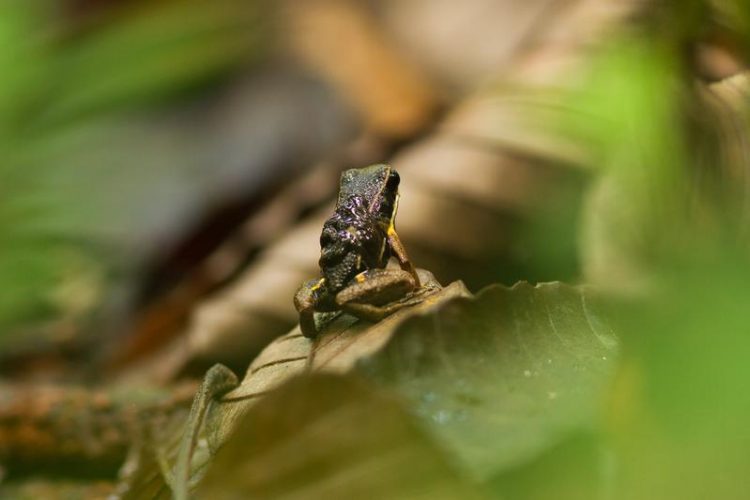Female frogs identify own offspring using inner GPS

In the brilliant-thighed poisonfrog, the males transport the tadpoles to nearby water bodies. Andrius Pašukonis
The brilliant-thighed poison frog Allobates femoralis is a ground-dwelling species inhabiting the tropical forests of South America. Males guard large territories in which females lay their eggs on fallen leaves. After three weeks of development, the tadpoles are generally transported on the backs of the males to the nearest body of water.
“Females only do so when the male is not in his territory at this time,” explains Eva Ringler from the Department of Comparative Cognitive Research at the Messerli Research Institute of Vetmeduni Vienna.
Own offspring should come first
Tadpole transport has its risks. The tadpoles will only survive if they are transported to a body of water at the right time. During transport, males leave their territory unguarded and risk territorial loss to rivals. Females, on the other hand, must discriminate their own clutch from a number of unrelated clutches. And on the way to the water, predators abound.
“Transport therefore only makes sense when the risk that is taken serves the survival of one’s offspring,” says Ringler. This assumes, however, that A. femoralis can identify its own offspring. “Especially interesting was whether there is a difference between male and female behaviour,” Ringler says.
Males play it safe
In a series of three terrarium trials, the researchers observed whether the frogs would transport only their own or also unrelated tadpoles. In the first test, males and females were presented only with an unrelated clutch. In the second test, an unrelated clutch was added to the terrarium of an individual that already had its own clutch. In the third test, the researchers exchanged the positions of the frog’s own clutch and a foreign clutch to see whether frogs recognize the clutch itself or remember the location of oviposition.
The tests showed that a majority of male frogs transported both their own as well as foreign clutches. They simply let all tadpoles present wiggle onto their back. The parental strategy of males apparently follows the rule of “my territory, my tadpoles”. Males therefore seem to forego the challenge of differentiation entirely.
Females remember the position of their clutch
The female strategy is quite different. They do not transport unrelated tadpoles. The females did not transport foreign tadpoles when they knew the position of their own clutch. But if the researchers switched the position of the female’s own clutch with another one, they only transported the unrelated clutch. This shows that, even weeks later, females remember the exact position where they laid their eggs. When they take over the tadpole transport, they choose the correct clutch based on its location.
Simple rule vs. inner GPS
The behaviour of the frogs in the study also indicated different cost/benefit calculations. Males, owing to their territorial behaviour, follow a simply rule. They assume that all clutches in their territory are theirs. Males therefore have a low risk of neglecting their own offspring. Their behaviour even offers unrelated tadpoles an increased chance of survival.
Females have a much higher risk of transporting a foreign clutch and neglecting their own. In their desire to transport only their own clutch, the female frogs rely on their inner GPS. “Further research is needed to clarify just how the females remember the exact location of oviposition in the dense rain forest,” Eva Ringler concludes.
Service:
The article “Sex-specific offspring discrimination reflects respective risks and costs of misdirected care in a poison frog” by Eva Ringler, Andrius Pašukonis, Max Ringler and Ludwig Huber was published in the journal Animal Behaviour. doi:10.1016/j.anbehav.2016.02.008
http://www.sciencedirect.com/science/article/pii/S0003347216000488
About the University of Veterinary Medicine, Vienna
The University of Veterinary Medicine, Vienna in Austria is one of the leading academic and research institutions in the field of Veterinary Sciences in Europe. About 1,300 employees and 2,300 students work on the campus in the north of Vienna which also houses five university clinics and various research sites. Outside of Vienna the university operates Teaching and Research Farms. http://www.vetmeduni.ac.at
Scientific Contact:
Eva Ringler
Messerli Research Institute (Unit of Comparative Cognition)
University of Veterinary Medicine, Vienna (Vetmeduni Vienna)
T +43 650 9780208
eva.ringler@vetmeduni.ac.at
Released by:
Georg Mair
Science Communication / Corporate Communications
University of Veterinary Medicine Vienna (Vetmeduni Vienna)
T +43 1 25077-1165
georg.mair@vetmeduni.ac.at
http://www.vetmeduni.ac.at/en/infoservice/presseinformation/presseinformationen-…
Media Contact
All latest news from the category: Life Sciences and Chemistry
Articles and reports from the Life Sciences and chemistry area deal with applied and basic research into modern biology, chemistry and human medicine.
Valuable information can be found on a range of life sciences fields including bacteriology, biochemistry, bionics, bioinformatics, biophysics, biotechnology, genetics, geobotany, human biology, marine biology, microbiology, molecular biology, cellular biology, zoology, bioinorganic chemistry, microchemistry and environmental chemistry.
Newest articles

First-of-its-kind study uses remote sensing to monitor plastic debris in rivers and lakes
Remote sensing creates a cost-effective solution to monitoring plastic pollution. A first-of-its-kind study from researchers at the University of Minnesota Twin Cities shows how remote sensing can help monitor and…

Laser-based artificial neuron mimics nerve cell functions at lightning speed
With a processing speed a billion times faster than nature, chip-based laser neuron could help advance AI tasks such as pattern recognition and sequence prediction. Researchers have developed a laser-based…

Optimising the processing of plastic waste
Just one look in the yellow bin reveals a colourful jumble of different types of plastic. However, the purer and more uniform plastic waste is, the easier it is to…



